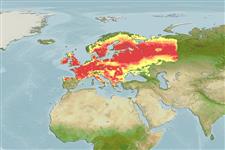分類 / Names
俗名 | 同種異名 | Catalog of Fishes (gen., sp.) | ITIS | CoL | WoRMS | Cloffa
Actinopterygii
輻鰭魚綱 (條鰭魚) >
Cypriniformes (Carps) >
Cyprinidae (Minnows or carps) > Leuciscinae
Etymology: Leuciscus: Greek, leykiskos = white mullet (Ref. 45335); leuciscus: From Greek leucos = bright, shining white.
環境 / 氣候 / 範圍
生態學
; 淡水; 半鹹淡水 底中水層性; pH range: 6.0 - 8.0; 河川洄游 (Ref. 51243); 深度上下限 1 - ? m. 4°C - 22°C (Ref. 41616), preferred ?; 72°N - 41°N, 10°W - 155°E
Europe and Asia: North, Baltic, White and Barents Sea basins; Caspian basin, in Volga and Ural drainages; Black Sea basin, from Danube to Dniepr drainages; Atlantic basin, in Seine drainage; Mediterranean basin from Rhône to Arch drainages (France). Only very localized in Danube main river in Romania, in Scandinavia north of 69°N and most of cenral Finland. Populations from Siberia and East Asia usually referred to Leuciscus leuciscus are distinct species, Leuciscus baicalensis and Leuciscus dzungaricus (Ref. 59043). Has become widespread in Europe and gained access to Ireland as a bait fish. At least one country reports adverse ecological impact after introduction (Ref. 1739).
Length at first maturity / 大小 / 重量 / 年齡
Maturity: Lm 17.9 range ? - ? cm
Max length : 40.0 cm TL 雄魚/尚未辨別雌雄; (Ref. 30578); common length : 15.0 cm TL 雄魚/尚未辨別雌雄; (Ref. 556); 最大體重: 1.0 kg (Ref. 30578); 最大年齡: 16 年 (Ref. 41616)
背棘 (總數): 2 - 3; 背的軟條 (總數): 7-9; 臀棘 3; 臀鰭軟條: 8 - 9; 脊椎骨: 42 - 46. Diagnosed from congeners in Europe by the following characters: subinferior or subterminal mouth; subequal jaw, upper jaw slightly longer; upper lip tip about level with center of eye; not projecting snout; articulation of lower jaw distinctly behind anterior margin of eye; horizontal branch of preoperculum shorter than vertical branch; and 40-50 + 1-2 scales on lateral line (Ref. 59043). Rarely longer than 30 cm TL; normally 47-52 scales in lateral line; anal fin concave; caudal fin forked with 19 rays (Ref. 41616).
Gregarious fish which swims near the surface (Ref. 30578). Inhabits moderate to fast-flowing large streams to large rivers with rock or gravel bottom. Adults aggregate in dense swarms in winter in the lower reaches of rivers or backwaters and often migrate to spawning streams in autumn and overwinter there. Juveniles spend winter in cavities along the shores. Early juveniles occur in very shallow shoreline habitats and when they grow, they leave the shores for faster-flowing waters. Feeding larvae thrive along shores. Prey on small invertebrates. Spawns in fast-flowing water on shallow gravel beds, often in small tributaries (Ref. 59043). Breeds in March and April (Ref. 30578). Pale yellow eggs are found attached to gravel and stones in shallow, flowing water (Ref. 41678).
Life cycle and mating behavior
成熟度 | 繁殖 | 產卵場 | 卵 | 孕卵數 | 仔魚
Regularly undertake migration of some tens of km to spawning sites, which are often situated in tributaries. Males form large aggregations, each male defending a small territory. Females lay sticky eggs into excavaitons made in gravel (Ref. 59043).
Kottelat, M. and J. Freyhof, 2007. Handbook of European freshwater fishes. Publications Kottelat, Cornol and Freyhof, Berlin. 646 pp. (Ref. 59043)
CITES (Ref. 94142)
Not Evaluated
人類使用
漁業: 沒有興趣; 游釣魚種: 是的; 誘餌: usually
更多資訊
參考文獻養殖養殖資訊品種遺傳學基因序列遺傳率疾病加工Mass conversion
合作者照片Stamps, Coins聲音神經毒速度泳型鰓區Otoliths腦重體重比眼睛色素
工具
特別的報告
下載 XML
網路資源
